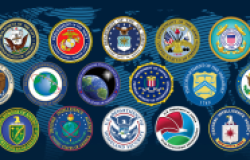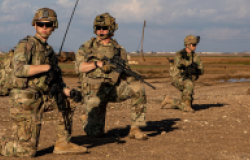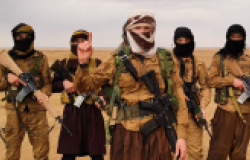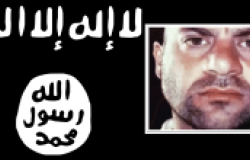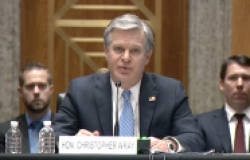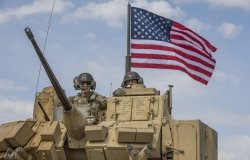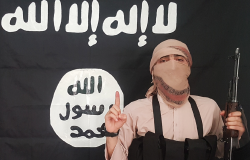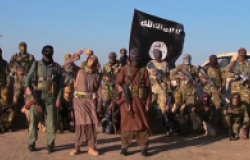Report: ISIS Human Rights Abuses in 2014
The brutality of non-state actors - particularly ISIS - was one of the most notable trends in human rights abuses in 2014, according to the State Department's Country Report on Human Rights Practices.
The brutality of non-state actors - particularly ISIS - was one of the most notable trends in human rights abuses in 2014, according to the State Department's Country Report on Human Rights Practices. In his preface, Secretary of State John Kerry noted that "violent extremists have made it clear that not only do they have zero regard for human rights; they have zero regard for human life." The following are excerpts from the report related to violent extremism.
Secretary of State John Kerry's Preface
For far too many people, 2014 was defined by suffering and abuse perpetrated by terrorist groups exploiting religious discourse and divisions to advance their totalitarian ideology, or by governments, such as Syria, sometimes acting in the name of combatting terrorism. In parts of the Middle East and Africa, violent extremists have made it clear that not only do they have zero regard for human rights; they have zero regard for human life, period. We’ve seen groups like ISIL burn human beings alive, barbarically behead prisoners, sell girls into slavery, and execute innocents widely and indiscriminately. Almost every week brings new examples of just how far the evil of these groups reaches. We all witnessed the brutality and nihilism of the horrific attacks by Pakistani Taliban and Boko Haram on schoolchildren, the assassinations of Charlie Hebdo journalists, and numerous outrages and killings carried out by ISIL. The rise of ISIL was in part a consequence of, and illustrated the dangers of, atrocities committed by the government of Syria and failures of inclusive governance in Iraq.
Click here to read more
Introduction
On the first Sunday in August, the terrorist organization Islamic State of Iraq and the Levant (ISIL) descended on the towns and villages that are the ancient home of the Yezidi people, one of many small ethno-religious minorities that has lived for centuries in the diverse lands encompassed by Iraq and the Levant. They attacked and killed hundreds of men, women, and children simply because of their faith. Some were shot in the back while fleeing; others were buried alive. Thousands of women were taken captive as sex slaves. The bodies of many of the victims were later found in mass graves. Escapees undertook a week-long journey on foot that ended atop a desolate mountain in the area of Sinjar in northwestern Iraq. Defenseless, lacking food or water, and besieged by ISIL, the remaining survivors of the Yezidi community faced terrible atrocities and what President Obama called “a potential act of genocide.” Kurdish forces, aided by U.S. airstrikes, forged a path to safety. ISIL’s advance through Iraq and Syria claimed many other victims – Christians, Turkomans, Shabak, Shia and Sunni Muslims – as it resurrected, as a core tenet of its ideology, the most terrifying practices of medieval warfare and conquest.
While our reports continue to focus on the behavior of governments – which bear responsibility for the promotion and protection of human rights and fundamental freedoms in their territories – the year 2014 will be remembered as much for atrocities committed by non-state actors. The brutality of these actors is one of the notable trends in the 2014 Country Reports on Human Rights Practices.
Terrorist organizations like ISIL, al-Qa’ida in the Arabian Peninsula (AQAP), al-Qa’ida in the Islamic Maghreb (AQIM), Boko Haram, al-Shabaab, Jabhat al-Nusra, and others perpetrated human rights abuses and violations of international humanitarian law against innocent non-combatants. Often, they sought to eliminate those who did not conform to their extreme views, including other Sunni Muslims. Some governments committed violations and abuses in response; such reactions to violent extremism often undermined efforts to contain it.
In Syria, government security forces and affiliated militias committed massacres, bombarded civilian neighborhoods, mistreated and abused prisoners, and employed rape as a weapon of war. ISIL and al-Nusra took advantage of the chaos by casting themselves as the best available defense to Asad’s atrocities, while committing a wide range of similar abuses of their own, including massacres, bombings, summary executions, and forced displacement based on sectarian identity. In the eastern provinces of Raqqa and Dayr al-Zawr, ISIL committed mass atrocities including executing up to 900 members of the al-Sheitaat tribe from Dayr al-Zawr. The terrorist group stoned women and men accused of adultery, crucified civilians, imposed forced marriage, raped kidnapped girls and women for the purpose of sexual slavery, and beheaded foreign journalists and aid workers, circulating videos of these crimes on social media.
In Iraq, in a systematic and widespread fashion, ISIL attacked individuals based on religion or ethnicity, raped women and children, and recruited child soldiers, while Shia militias and volunteers in Popular Mobilization Committees perpetrated violence and criminal acts. Widespread corruption and the government’s inability to rein in abusive actions by security forces and militias led to popular mistrust in the government. Prime Minister Abadi has pledged, however, to tackle these problems.
In Nigeria, Boko Haram attacks resulted in the deaths of more than 4,000 civilians in 2014 alone, and the displacement of tens of thousands. In April, Boko Haram kidnapped 273 girls from the Chibok Government Girls Secondary School; most of the girls were still missing at year’s end. Deadly attacks and abductions in neighboring Cameroon expanded the terrorist group’s reach across Nigerian borders. Regional and international partners mobilized to respond, but high levels of corruption within the Nigerian military, along with the poor human rights record of Nigerian security services, undermined efforts to effectively combat Boko Haram.
In Somalia and Kenya, attacks by the terrorist group al-Shabaab continued throughout the year, killing many civilians. In December, the Pakistani Taliban committed the worst atrocity against schoolchildren in Pakistan in a decade – by killing, at times execution-style, 132 students. In South Sudan, government and opposition forces used an estimated 10,000 children to perpetuate the country’s internal conflict, which has displaced over 1.5 million people.
In Yemen, AQAP kidnapped for ransom and continued to attack civilians with suicide bombers, causing numerous deaths. In Algeria, attacks by AQIM killed innocent civilians. At the same time, authoritarian states continued to use violence or regressive laws to silence domestic dissidents, sometimes in the name of fighting terrorism or foreign threats.
Click here to read more
Iraq
Destabilizing violence and fighting between government forces and ISIL escalated in Anbar Province at the end of 2013 and spread to other provinces during the year. On June 9, ISIL launched an assault and quickly captured Mosul, the second largest city. Subsequently ISIL forces took control of large areas of Anbar, Ninewa, Salah ad Din, and Diyala provinces. Armed clashes between ISIL and the ISF, including the Peshmerga--the armed forces of the Kurdistan regional government--caused massive internal displacements, with the United Nations estimating more than two million persons forced to flee their homes nationwide. The humanitarian crisis worsened in July and August, as ISIL targeted ethnic and religious minorities, perpetrated gender-based violence, sold women and children off as slaves, recruited child soldiers, and destroyed civilian infrastructure.
Severe human rights problems persisted. Large-scale and frequent killings, the vast majority of which ISIL carried out, destabilized the country. They included the June 10 mass killing of more than 600 inmates, almost all Shia, at Badoush prison near Mosul. ISIL also killed, abducted, and expelled from their homes members of religious and ethnic groups, including Christians, Shia Shabak, Shia Turkmen, and Yezidis. Simultaneously, but on a much smaller scale, there were unverified reports of government actors and Shia militias killing Sunni prisoners. Widespread corruption at all levels of government and society exacerbated the lack of effective human rights protections.
Terrorist groups, most notably ISIL, on a mass scale committed acts of violence, including killing by means of suicide bombings, improvised explosive devices, execution-style shootings, and beheadings. These groups also engaged in kidnapping, rape, and other forms of violence. Terrorists targeted fellow citizens, including Shia, Sunni, and members of other religious groups or ethnicities, as well as security forces, places of worship, religious pilgrims, schools, public spaces, economic infrastructure, and government officials. The government initiated investigations of ISIL’s human rights abuses, for instance the massacre of Air Force recruits at Camp Speicher and the targeted killing of Yezidis in Sinjar, but progress was slow and the status of official prosecutions unknown. Information about investigations or prosecutions of abuses by government officials and members of the security forces was not publicly available.
Click here to read more
Syria
Some extremist opposition organizations, including armed terrorist groups such as the al-Qaida-linked Jabhat al-Nusra, also committed a wide range of abuses, including massacres, bombings, and kidnappings; unlawful detention; torture; summary executions; and forced evacuations from homes based on sectarian identity. ISIL took control of the eastern provinces of Raqqa and Dayr al-Zawr, where it committed massive human rights abuses, according to numerous human rights organizations, the media, UN reports, and ISIL itself. According to the media and eyewitnesses, these included the mass execution of 700-900 members of the Sheitaat tribe from Dayr al-Zawr; stonings of women and men accused of adultery; crucifixions of civilians; forced marriages of kidnapped girls and women; and public beheadings of foreign journalists, aid workers, and others. Human trafficking increased, including the forcible recruitment and use of children in the conflict, as well as reports of forced marriages of women and underage girls for the purpose of sexual slavery among ISIL fighters.
Click here to read more
Related Program

The Islamists
Learn more about Hamas and how it relates to similarly aligned organizations throughout the region. Read more
